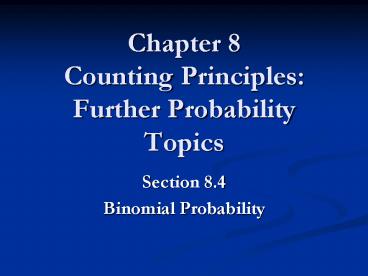Chapter 8 Counting Principles: Further Probability Topics - PowerPoint PPT Presentation
1 / 10
Title:
Chapter 8 Counting Principles: Further Probability Topics
Description:
Find the probability of rolling exactly 7 fives. n = # trials = 10. success: rolling a five ... 60%. For the five new waiters just hired, what is the ... – PowerPoint PPT presentation
Number of Views:96
Avg rating:3.0/5.0
Title: Chapter 8 Counting Principles: Further Probability Topics
1
Chapter 8Counting Principles Further
Probability Topics
- Section 8.4
- Binomial Probability
2
- Many probability problems are concerned with
experiments in which an event is repeated many
times. - Probability problems of this kind are called
Bernoulli trials, or Bernoulli processes. - In each case, some outcome is designated a
success, and any other outcome is considered a
failure. - Bernoulli trials problems are sometimes referred
to as binomial experiments.
3
Binomial Experiments
- The following criteria must be met
- 1.) The same experiment is repeated several
times. - 2.) There are only two possible outcomes,
success and failure. - 3.) The repeated trials are independent, so that
the probability of success remains the same
for each trial.
4
- A single die is rolled four times in a row.
Getting a 5 is a success, while getting any
other number is a failure. - a.) Why is this a binomial experiment?
- Already classified outcomes as successes or
failures. - Experiment is repeated several times.
- Outcomes are independent when rolling a single
die.
5
- A single die is rolled four times in a row.
Getting a 5 is a success, while getting any
other number is a failure. - b.) Find the probability of having 3 successes
followed by 1 failure. - P(S ? S ? S ? F)
6
- A single die is rolled four times in a row.
Getting a 5 is a success, while getting any
other number is a failure. - c.) Find the probability of having 3 successes
- and 1 failure, in any order.
- Possible Outcomes
- SSSF SSFS SFSS FSSS
- Thus, P(3S ? 1F) 4 ( )
7
Binomial Probability Formula
- If p is the probability of success in a single
trial of a binomial experiment, the probability
of x successes and n-x failures in n independent
repeated trials of the experiment is - n of trials
- x of successes
- p probability of success
8
- Example A single die is rolled 10 times. Find
the probability of rolling exactly 7 fives. - n trials 10
- success rolling a five
- x successes 7
- p prob. of success 1/6
9
- Example A restaurant manager estimates the
probability that a newly hired waiter will still
be working at the restaurant six months later is
only 60. For the five new waiters just hired,
what is the probability that at least four of
them will still be working at the restaurant in
six months? Assume that the waiters decide
independently of each other. - n 5
- x 4 or 5
- p 0.6
10
- Example A flu vaccine has a probability of 80
of preventing a person who is inoculated from
getting the flu. A county health office
inoculates 87 people. Find the probabilities of
the following. - a.) Exactly 15 of the people inoculated get the
flu. - b.) No more than 3 of the people inoculated get
the flu. - c.) None of the people inoculated get the flu.































